[Chapter 2] Section 3 ①
1. Lanyard selection
1. Shock absorber selection
- If it is possible to carry out work by attaching the hook, etc. at waist height or higher, select a Type 1 shock absorber.
- If it is necessary to carry out work by attaching the hook, etc., below the feet in steel frame assembly work, etc., select the full harness type and select a Type 2 shock absorber.
- When there is a mixture of both types of work, select the full harness type and select a Type 2 shock absorber.
(The standard for a Type 2 shock absorber is 6 kN. This is not suitable for body belts, so it is specified to “select the full harness type…”)
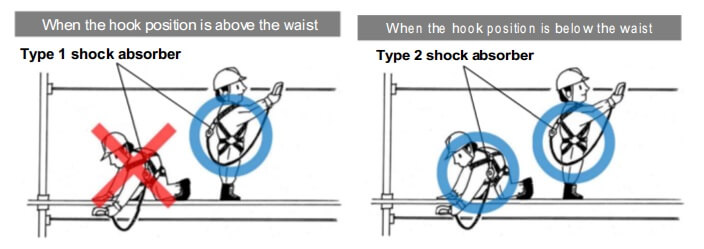
In work via work positioning, there is usually no work where the hook, etc. is attached under the feet, so select a Type 1 shock absorber.
However, if the content of the work includes work where the hook, etc. is attached under the feet, a Type 2 shock absorber should be selected.
2. Selection of equipment based on body weight, etc.
A maximum usable weight is specified for fall arrest equipment(85 kg or 100 kg, excluding special-order products). Therefore, select equipment so that the total weight of the person using the equipment and their tools/accessories does not exceed the maximum weight.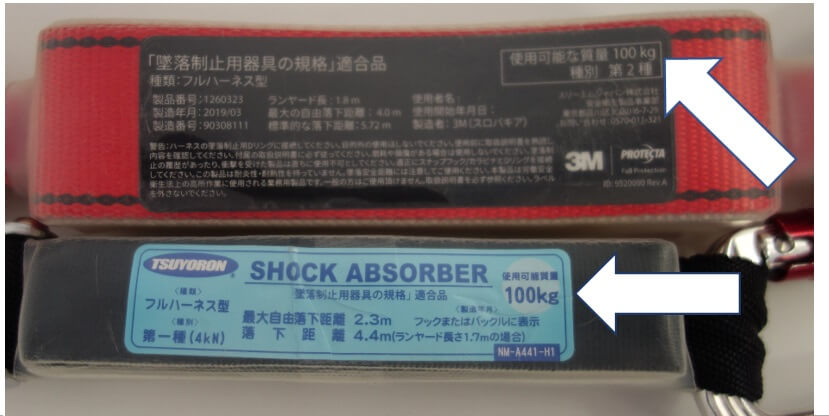
3. Select instruments based on the height of the work place and the nature of the work.
- Check the fall distance under the standard conditions indicated on the lanyard, and select an appropriate lanyard primarily based on the height at which work will be done.
- A winding lanyard with lock function has a shorter fall distance than an ordinary lanyard, so use of this type is recommended primarily when height of the work place is relatively low.
- To prevent falling when reattaching a hook, etc. during movement, it is desirable to use a method where two hooks, etc. are alternately and continuously attached (double lanyard).
- When employing the double lanyard method with the full harness type, use two lanyards for fall arrest.
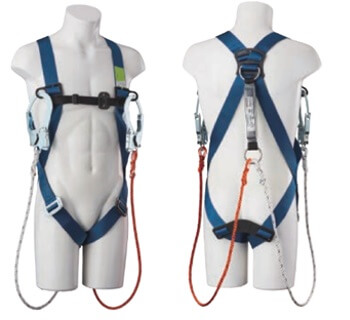
※ There is a risk that the shock absorber for the double lanyard method may not function, depending on how the hooks are attached, so caution is necessary.
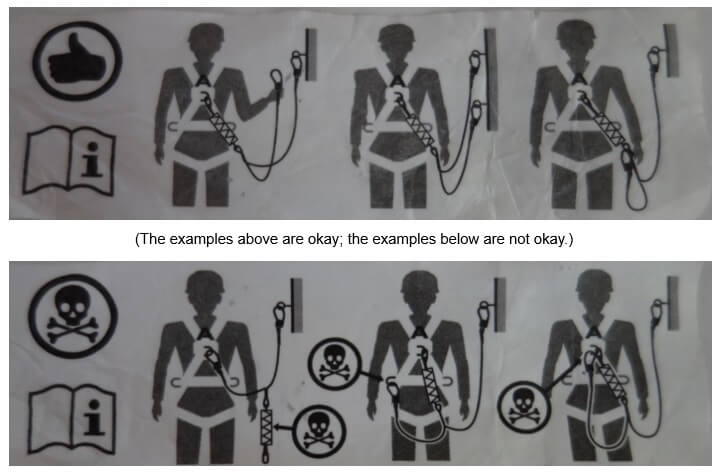
[Pictograms indicating risk that the shock absorber will not function properly (example taken from an overseas manufacturer)]
When using the double lanyard method, it is desirable to use two lanyards for fall arrest, but it is also acceptable if one of the two is a rope for work positioning. In this case, use with the necessary minimum length of rope, set by using the length adjuster.
2. Mounting equipment for fall arrest equipment
- Mounting equipment for fall arrest equipment must have no risk of the lanyard coming loose or off, and be strong enough to fully withstand the impact force at the time of fall arrest.
Do not attach a hook, etc. if the strength of mounting equipment cannot be determined.
If a hook, etc. must unavoidably be attached to mounting equipment of unknown strength due to the work situation, measures should be taken to reduce the impact load at the time of fall arrest, within the scope of the strength of the mounting equipment, by for example attaching the hook, etc. at a position that is as high as possible.
- If there is a sharp corner in the vicinity of mounting equipment for fall arrest equipment, take measures such as masking so that lanyard ropes, etc. do not directly touch the sharp corner.
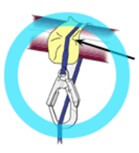
3.How to use fall arrest equipment
-
Attach the hook at a high place above the waist in order to reduce the shock in case of a fall.
As the object the hook is attached to, select something strong enough to withstand the impact of fall arrest.
-
Attach the hook facing straight down.
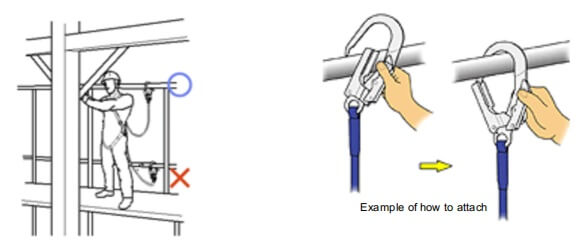
-
When attaching to a vertical structure or diagonal member, etc., set so the lanyard does not shift or rub against the structure during fall arrest.
-
As far as possible, attach fall arrest equipment at a location that will prevent the worker from swinging like a pendulum and colliding with objects in case of a fall.
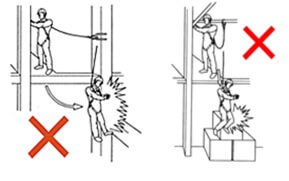
-
The auxiliary rope is used for reattaching when moving. It should not be used during ordinary work.
4.How to use fall arrest equipment(When used together with work via work positioning)
As a general rule, select mounting equipment at a position above the head.
When attaching to a vertical structure or diagonal member, etc., set so the lanyard does not shift or rub against the structure during fall arrest.
When using work positioning equipment, first confirm there is no twisting of the rope. Then visually check that the hook, etc. is securely attached to the ring. Adjust the length of the rope to the minimum length necessary for the work using the length adjuster. When applying your body weight, do not suddenly release your hands and apply weight. Gradually transfer your weight and release your hand after confirming that there is nothing wrong.
The work positioning rope can be used to prevent a fall when reattaching while moving. However, another lanyard that meets the requirements as fall arrest equipment must be used when performing work. L
ength should be kept to the minimum necessary for use while reattaching the work positioning rope.
5. How to use the hook, etc.
The performance of a hook, etc. is specified in terms of the tensile load applied to the mounting point of the rope, etc. and the center of the hook part in a lanyard. The hook is used while recognizing that it cannot withstand large loads in terms of bending loads and external forces on the latch.
Attachment by wrapping around should be avoided as far as possible due to the risk of problems such as lateral bending loads on the hook, etc., or breakage due to stress concentration at sharp corners of the mounting equipment.
When attaching by wrapping around, take care to understand these problems and avoid them.If the rope, etc. of the lanyard is twisted and entangled with a latch device such as the hook, the latch may deform, break and come off, so be careful.
If there is a shock absorber at the mounting point of the hook, etc. of the lanyard, the shock absorber may not function if the hook, etc. is attached to the shock absorber by wrapping around, so do not wrap around.
[Incorrect methods of attachment]
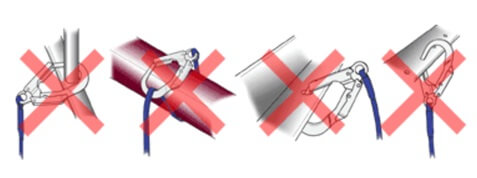
受講者様のご希望に合わせ、以下のタイプの講習会もご用意しています


このページをシェアする
講習会をお探しですか?